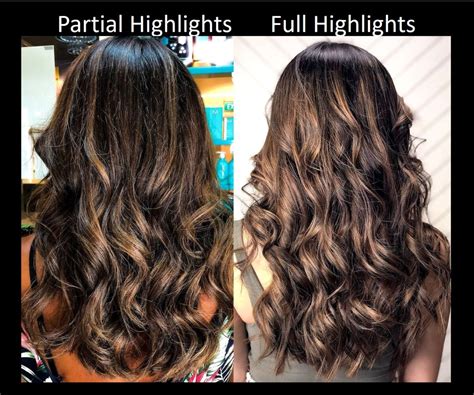When it comes to hair highlighting, there are two main options: partial highlights and full highlights. Both techniques can create beautiful, sun-kissed locks, but the differences between them may help you decide which option is right for you.

Partial Highlights:
- Description: Partial highlights only involve applying color to select strands of hair, typically at the crown or around the face.
-
Benefits:
- Less expensive than full highlights
- Better for those with shorter hair or those who desire a more subtle effect
- Requires less maintenance
Full Highlights:
- Description: Full highlights involve applying color to all of the hair, from roots to tips.
-
Benefits:
- Creates a more dramatic, even-toned look
- Ideal for those with longer hair or who want a more noticeable change
- Requires more maintenance
Choosing Between Partial and Full Highlights:
The best way to decide which highlighting technique is right for you is to consider your hair type, desired look, and lifestyle.
Table 1: Pros and Cons of Partial Highlights
| Pros | Cons |
|---|---|
| More affordable | Less dramatic effect |
| Less maintenance | May appear patchy over time |
| Subtler result | May not create the desired level of contrast |
Table 2: Pros and Cons of Full Highlights
| Pros | Cons |
|---|---|
| More even-toned result | More expensive |
| More noticeable change | Requires more maintenance |
| Can be used to create dramatic effects | May not be suitable for all hair types |
Cost Comparison:
The cost of highlighting services varies depending on factors such as the length of your hair, the desired look, and the salon you visit. Generally, full highlights cost more than partial highlights.
Maintenance:
Proper hair care is essential to maintain the health and vibrancy of your highlights. Here’s a summary of the maintenance requirements for each technique:
Table 3: Hair Care Routine for Highlighted Hair
| Maintenance Task | Partial Highlights | Full Highlights |
|---|---|---|
| Touch-ups | Every 6-8 weeks | Every 4-6 weeks |
| Deep conditioning | Monthly | Bi-weekly |
| Protein treatments | As needed | As needed |
Self-Highlighting:
While professional highlighting is generally recommended, it is possible to achieve highlights at home. However, it is important to note that DIY highlighting can be unpredictable and may damage your hair if not done correctly.
Here’s a step-by-step approach to partial highlighting at home:
- Section off your hair into 4-6 sections.
- Use a highlighting comb to comb color through select strands in each section.
- Leave the color in for the recommended amount of time and then rinse thoroughly.
- Condition your hair to prevent dryness and damage.
Benefits of Highlights:
Regardless of the technique you choose, highlights offer a range of benefits, including:
- Table 4: Benefits of Hair Highlights
| Benefit |
|—|—|
| Adds dimension and depth to hair |
| Creates a more youthful appearance |
| Enhances natural hair color |
| Conceals gray hairs |
| Can flatter various face shapes and skin tones |
Inspirational and Creative Ideas:
- Balayage: A freehand highlighting technique that creates a soft, natural-looking effect.
- Ombré: A gradual transition of color from roots to tips, often using a darker shade at the roots and a lighter shade at the ends.
- Sombre: A subtle ombré effect that creates a more sophisticated, blended look.
- Foilayage: A combination of balayage and foiling that allows for precise placement of highlights.
Conclusion:
Partial vs. full highlights are both excellent options for adding a touch of color and dimension to your hair. Consider your hair type, desired look, and lifestyle factors to determine which technique is right for you. With proper care and maintenance, highlights can enhance your natural beauty and boost your confidence for years to come.
